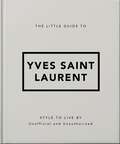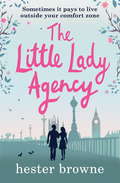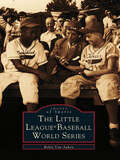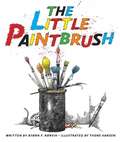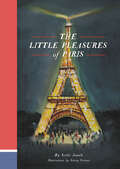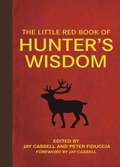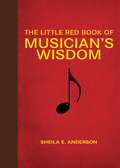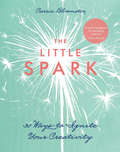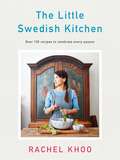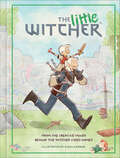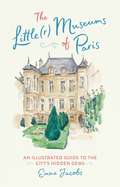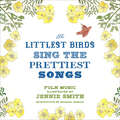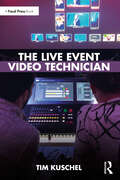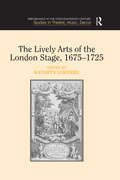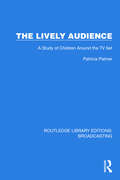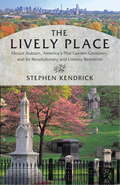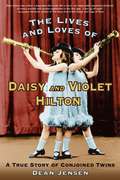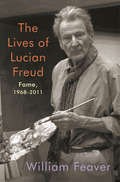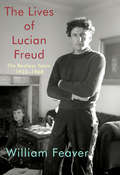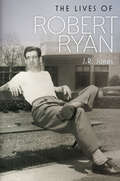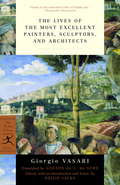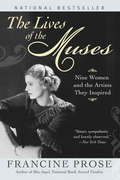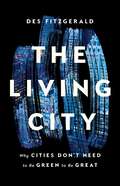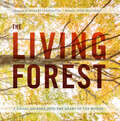- Table View
- List View
The Little Guide to Yves Saint Laurent (The\little Book Of... Ser.)
by Orange Hippo!Yves Saint Laurent, or YSL, is one of the most famous fashion designers of all time, whose impact on the fashion world is almost unmatched. A revolutionary designer for women, his designs took traditionally male styles and reinvented them for the modern women of the 1960s. From jumpsuits to safari jackets to his iconic tuxedo, YSL's designs revolutionised women's clothes forever. He can be credited with making ready-to-wear clothes reputable and desirable, in a marked move away from haute couture, and for championing trousers for women.Despite a life marred with addiction, war and mental health struggles, Yves remained a powerhouse of the fashion industry for 50 years, and his name – and initials – are now synonymous with quality, innovation and heritage. His collections may have sometimes generated controversy and criticism, but they have proved to be timeless and transformative.The Little Guide to Yves Saint Laurent charts his tumultuous rise to the top, accompanied by facts and quotes from, and about, the man himself and the fashion legacy he built.
The Little Guide to Yves Saint Laurent (The\little Book Of... Ser.)
by Orange Hippo!Yves Saint Laurent, or YSL, is one of the most famous fashion designers of all time, whose impact on the fashion world is almost unmatched. A revolutionary designer for women, his designs took traditionally male styles and reinvented them for the modern women of the 1960s. From jumpsuits to safari jackets to his iconic tuxedo, YSL's designs revolutionised women's clothes forever. He can be credited with making ready-to-wear clothes reputable and desirable, in a marked move away from haute couture, and for championing trousers for women.Despite a life marred with addiction, war and mental health struggles, Yves remained a powerhouse of the fashion industry for 50 years, and his name – and initials – are now synonymous with quality, innovation and heritage. His collections may have sometimes generated controversy and criticism, but they have proved to be timeless and transformative.The Little Guide to Yves Saint Laurent charts his tumultuous rise to the top, accompanied by facts and quotes from, and about, the man himself and the fashion legacy he built.
The Little Lady Agency: the hilarious bestselling rom com from the author of The Vintage Girl (The Little Lady Agency)
by Hester Browne'A delicious, witty story. I loved it! SOPHIE KINSELLAGentlemen! No Little Lady in Your Life? Call the Little Lady Agency: everything organised, from your home to your wardrobe, your social life to you. No funny business or laundry.When Melissa is made unfairly redundant from her job at an estate agents' office, she decides it's time for a change. Instead of working for other people, Melissa will go into business for herself: using her organisational skills to whip the lives of London's socially and romantically challenged men into shape.But then Melissa meets Jonathan, and suddenly she must decide if she can mix business with pleasure . . .***READERS LOVE THE LITTLE LADY AGENCY'A heart-warming love story' *****'Very relaxing, enjoyable, entertaining and diverting' *****'Left me with a huge smile on my face' *****'Like a pair of comfy slippers on a cold night' ********Read the rest of Hester Browne's hilarious Little Lady series:The Little Lady AgencyLittle Lady, Big AppleWhat the Lady Wants
The Little League® Baseball World Series (Images of Sports)
by Robin Van AukenLittle League Baseball is a microcosm of American history, filled with countless anecdotes, good fortune, adversity, and hope. In 1947, when the first Little League Baseball World Series was played, there were seventeen leagues in two states. Since then, Little League has achieved global recognition and has touched the lives of children and families in more than one hundred countries. The World Series is the culmination of dedication and teamwork in more than sixteen thousand games ending in a sixteen-team tournament in Williamsport, Pennsylvania. The Little League Baseball World Series remembers the history of the tournament and its role in bringing together communities. More than two thousand five hundred spectators witnessed the first championship game in 1947, when the Maynard Midgets took home the trophy, and the results were printed in newspapers around the country. Now, millions more tune in to ABC's Wide World of Sports and ESPN for live coverage of the final game. Little League Baseball has enriched the lives of more than thirty million boys and girls who have worn a Little League uniform. Well-known figures such as Derek Jeter, Kevin Costner, and Pres. George W. Bush were all Little League players. The Little League Baseball World Series celebrates this rich baseball history and the best teams the league has produced through the years.
The Little Paintbrush
by Thore Hansen Bjørn F. RørvikThe little paintbrush is often teased by all the other brushes in the cabinet, who have thick bristles and are chosen by their artist to create many paintings.<P><P> They boast all day about the pieces they've helped create, and the little paintbrush yearns to be like them. One day, the little paintbrush is thrown out of the cabinet as he tries to inch out to be noticed. Alone and disheveled, he befriends an old broom who consoles him. Then, one night, a thief breaks into the artist's house and it's up to the little paintbrush to warn the artist--who is none other than Edvard Munch!After driving the thief away, Munch is inspired by the little paintbrush and his valiant efforts. Together they create a new masterpiece, The Scream. And from then on, the little paintbrush becomes Munch's favorite. This magical tale teaches kids about one of history's most famous paintings through the story of one little paintbrush who becomes a big talent.
The Little Pleasures of Paris
by Leslie Jonath Lizzy StewartTake an enchanting tour of Paris's most charming places, objects, and pasttimes in this lovingly compiled Francophile handbook. Organized by season, The Little Pleasures of Paris takes the reader through a year's worth of quintessentially Parisian experiences, from secret gardens bursting with roses to exotic plumage at the city's bird market, candied violets at Paris's oldest sweet shop, dazzling colors in the stained glass at Sainte-Chapelle, and more. The friendly text and whimsical illustrations make this delightful ebook a poetic letter to the City of Light. Unusual details that might otherwise go unnoticed are celebrated and offer a uniquely intimate perspective in this triomphe of je ne sais quoi and joi de vivre!
The Little Red Book of Hunter's Wisdom (Little Red Books)
by Jay Cassell Peter FiducciaThe Little Red Book of Hunter’s Wisdom is packed full of thoughtful and witty quotes on the essence of man and his relationship to the hunt, with all its joys, idiosyncrasies, and challenges. Being a true hunter is a way of life, and this book is packed with memorable comments from men and women who live and breathe it. Read musings on the hunt from such noteworthy folks as:Ernest HemingwayAnnie OakleyRudyard KiplingDavid MametWilliam FaulknerMarco PoloAnd hundreds of others!The Little Red Book of Hunter’s Wisdom has words to live by for any outdoors enthusiast who enjoys a weekend in the woods or a relaxing Sunday on the lake. Whether you gobble it all up in one day or enjoy it over your lifetime, the wisdom in this book will last forever.
The Little Red Book of Musician's Wisdom (Little Red Books)
by Sheila E. AndersonCelebrating both the famous and the obscure from every genre of music--including classical, rock, Latin, country, blues, and hip-hop, The Little Red Book of Musician's Wisdom offers a touching anecdote or pithy line for every musical occasion. Musicians, critics, DJs, and industry onlookers provide illuminating commentary on a wealth of topics: Singing, rehearsing, and performing Success, fame, and fortune Failure and rejection Music critics and industry bigwigs Love, passion, and sex Aging and death Humor and wit Religion and spiritualityIndividual sections pay particular homage to the words of Ron Carter, T. S. Monk, The Beatles, and Benny Golson. Musicians, music lovers, and those who love hearing from the talented and famous will savor this collection of provocative, mischievous, and profound words from musical personalities of the past and present."Music is the divine way to tell beautiful, poetic things to the heart."--Pablo Casals"No two people on earth are alike, and it's got to be that way in music, or it isn't music."--Billie Holiday"Most of the times, once you're out of the limelight is when you want to be in it."--Tina Turner"The sign of a mature musician is knowing what not to play."--Dizzy Gillespie
The Little Spark: 30 Ways to Ignite Your Creativity
by Carrie Bloomston&“Tips for finding and nourishing the inner artist . . . chock-full of concrete, hands-on tips that can help the newbie develop habits of creativity.&”—Publishers Weekly (starred review) You were born with a creative spark inside. Do you look at yourself now and wonder if the spark has gone out? Ignite that inner fire with the 30 engaging exercises, fun activities, inspirational images, and motivating ideas in this book. Learn what your Little Spark of creative passion looks like, how to capture it, and how to make room for it in your life. Read the book cover-to-cover and use it as a month-long creative roadmap, or just dip into the exercises as your time and inclination allow. Either way, you will change your life. &“An interactive workbook for igniting creativity. It&’s peppered with tales from dancers, yogis, artists and more, and is filled with fun ideas.&”—Associated Press &“One of those books with its own energy and enthusiasm that literally lights you up!&”—David Romanellii, author of Life Lessons from the Oldest and Wisest &“The book&’s design beautifully weaves together text, blank write-in spaces, stellar photos and a host of other charming design elements. A sparkling blueprint for stimulating creativity.&”—Kirkus Reviews &“The color photographs and layout of the book are particularly pleasing and inspiring . . . A beneficial and enjoyable title for people who need a bit of a nudge to try something creative, or those who used to paint, write, or sew, who want to do it again.&”—Library Journal &“For any person you know who wants to make stuff, any kind of stuff, that is an authentic expression of themselves.&”—Quilt Journalist Newsletter
The Little Swedish Kitchen
by Rachel Khoo'A joy to behold' Yotam OttolenghiLearn how to cook the Swedish way with this beautiful book of over 100 delicious recipes. Spring picnics on the archipelago; barbecues at the summer cabin; cosy autumnal suppers; and dark snowy winters filled with candlelight, gingerbread and glögg - the Swedes love to celebrate every season via the food they eat. Complete with stunning location and food photography, and over 100 beautiful, fuss-free recipes, this cookbook lets you in on what the Swedish call lagom . . . the art of not too little, not too much, but just the right amount. Explore the nation's simple and balanced approach to cooking, sample their best-loved ingredients and discover a must-try cuisine that is about far more than just meatballs, fika and cinnamon buns . . . _________________Inside you'll find recipes for sunny days or cosy evenings, celebrations or nights curled up at home, such as:· POACHED CHICKEN WITH QUICK PICKLED STRAWBERRY SALAD. The ultimate barbecue salad. Replace the chicken with grilled halloumi cheese for a delicious vegetarian alternative.· PEAS, POTATOES AND CHICKEN IN A POT. The one dish delight: summer comfort food that's perfect for midweek. · MIDSUMMER MERINGUE CROWNS. The Swedes have been wearing flower crowns since long before festival-goers discovered them. Now you can make beautiful edible ones for parties or puddings.· PLUM TOSCA CAKE. This Swedish favourite, named after Puccini's opera, is filled with tart plums and sweet almonds._________________'I am so ready to race home and devour these fun, effortless and beautiful recipes that just beg to be cooked' Melissa Hemsley'The magic of Sweden's beautiful seasons comes alive . . . a real celebration of seasonal Swedish home cooking and tradition with Rachel's trademark inspirational twists!' Donal Skehan
The Little Witcher
by Bartosz Sztybor Alex Sutton Jacek Rembis Rafal Babraj Nadia Gasik Katarzyna Grzyb Sebastian Kalemba Katarzyna Krainska Lukasz Ludkowski Tomasz Matera Krzysztof Muciak Milena Zajac Marcin ZwierzchowskiPutting a Witcher twist on family life, this delightful collection of comics features Geralt of Rivia as your average monster-slaying dad, trying to raise young Ciri to be a good kid while teaching her all about life as a witcher—a perfect gift for parents and The Witcher fans of all ages.Young Ciri's extensive training at Kaer Morhen, the witchers' stronghold, includes everything she needs to learn to survive the many threats in her world . . . as well as all the antics and fun of a little girl bonding with her adoptive dad and family.With help from Geralt and Ciri's closest companions—including the motherly magic of Yennefer of Vengerberg and the wisdom of uncle Vesemir—these adorable tales of a non-traditional family will make you laugh, make you sigh, and make you realize that raising a Little Witcher is not that different from raising any other kid. Sure, bedtime stories might include warnings of monsters who fart when surprised, and Geralt might invoke the Witcher Code to get Ciri to brush her teeth or clean her room, but even the formidable White Wolf knows to surrender when it comes to bedtime battles or Afternoon Tea with the toys.The Little Witcher is perfect for:The Witcher fans raising little Ciris of their ownReaders who believe in the power of chosen familiesBaby showers (don&’t forget Dad!)Father&’s Day or Mother&’s Day giftsPlayers looking for a light-hearted twist on their favorite gameFamilies who like cute, magical comicsThe Witcher fans looking to spend more time in Kaer Morhen
The Little(r) Museums of Paris: An Illustrated Guide to the City's Hidden Gems
by Emma JacobsDiscover a new side of Paris, hidden in plain sight, with this beautifully illustrated guide to the city's smaller collections and best-kept secrets, from artists' studios to scientific museums. A visit to Paris can often seen like a highlight reel -- the Louvre, the Musee d'Orsay, the Eiffel Tower. But Paris isn't only about the big attractions; in fact, some might say it's the offbeat destinations that hold the greatest treasures. The Little(r) Museums of Paris takes a whimsical journey through these smaller destinations, from the fantastical to the bizarre, offering both a guide to the city and inspiration for armchair travelers. Rather than traveling by neighborhood, this charming guide explores the different types of institutions nestled within Paris, from time capsules like the Musee Nissim de Camondo to explorations of the world beyond the city limits, including the Institute of the Arab World. Readers will peek behind the curtains of artists' apartments and into the microscopes of collections of scientific oddities. Each entry opens up a new world of adventure, with a description of the museum's collection, as well as a short history, watercolor illustrations, and a miniature map. For residents and visitors alike, the captivating illustrations and deeply-researched yet approachable writing will encourage greater appreciation of the cultural diversity, history, and colorful characters that give Paris that je ne sai quoi.
The Littlest Birds Sing the Prettiest Songs: Folk Music
by Michael Hurley Jennie SmithOur love affair with folk songs runs as deep as the enduring power of music, nature, creativity, and the longings of the human heart. Artist Jennie Smith celebrates the tradition with her illustrated renderings of thirteen soulful songs, including time-honored Scottish ballads, classics by the likes of the Carter Family, contemporary favorites by Gillian Welch, and more. Smith's art--hopeful, sincere, and delicate--adds an unexpected and charming dimension to a familiar genre. With a foreword from contemporary folk legend Michael Hurley, complete lyrics, and playable tablature or sheet music for each song, this is a keepsake collection for the whole family to treasure.
The Live Event Video Technician
by Tim KuschelThe Live Event Video Technician covers terms, format types, concepts, and technologies used in video production for corporate meetings, concerts, special events, and theatrical productions. The book begins by providing a history of the industry and an overview of important roles and functions therein. It then discusses various display technologies such as LED walls and video projection, as well as video systems for converting and switching of various types of sources. Presenting the cornerstone formats, connectors, and methodologies of visual technology, this book offers a strong foundation to help readers navigate this ever-changing field. Written in an accessible tone, the book clarifies jargon and is an overarching source of knowledge for the role of the video technician, for which there has previously been little formal training. The Live Event Video Technician provides a wealth of practical information for students of media and communications courses, readers with a novice or entry-level understanding of video and AV production, and anyone with an interest in working as technical personnel in live event production.
The Lively Arts of the London Stage, 1675–1725 (Performance in the Long Eighteenth Century: Studies in Theatre, Music, Dance)
by Kathryn LowerreUnlike collections of essays which focus on a single century or whose authors are drawn from a single discipline, this collection reflects the myriad performance options available to London audiences, offering readers a composite portrait of the music, drama, and dance productions that characterized this rich period. Just as the performing arts were deeply interrelated, the essays presented here, by scholars from a range of fields, engage in dialogue with others in the volume. The opening section examines a famous series of 1701 performances based on the competition between composers to set William Congreve's masque The Judgment of Paris to music. The essays in the central section (the 'mainpiece') showcase performers and productions on the London stage from a variety of perspectives, including English 'tastes' in art and music, the use of dance, the depiction of madness and masculinity in both spoken and musical performances, and genres and modes in the context of contemporary criticism and theatrical practice. A brief afterpiece looks at comic pieces in relation to satire, parody and homage. By bringing together work by scholars of music, dance, and drama, this cross-disciplinary collection illuminates the interconnecting strands that shaped a vibrant theatrical world.
The Lively Audience: A Study of Children Around the TV Set (Routledge Library Editions: Broadcasting #25)
by Patricia PalmerThe Lively Audience (1986) studies television from the children’s own point of view. Contrary to most prevailing opinion, it contends that television has much to teach children, and that their relationship with the medium is not one of passive dependency after all. Research shows that what children gain from television depends very much on the child’s age and social experience, and that children ‘see’ television differently from adults. This book examines this issue, and gives us a different understanding of the child audience and the impact of their television viewing.
The Lively Place
by Stephen KendrickThe story of one of the Boston area's most famous attractions, the Mount Auburn Cemetery, and how its founders and "residents" have influenced American culture When the Mount Auburn Cemetery was founded, in 1831, it revolutionized the way Americans mourned the dead by offering a peaceful space for contemplation. This cemetery, located not far from Harvard University, was also a place that reflected and instilled an imperative to preserve and protect nature in a rapidly industrializing culture--lessons that would influence the creation of Central Park, the cemetery at Gettysburg, and the National Parks system. Even today this urban wildlife habitat and nationally recognized hotspot for migratory songbirds continues to connect visitors with nature and serves as a model for sustainable landscape practices. Beyond Mount Auburn's prescient focus on conservation, it also reflects the impact of Transcendentalism and the progressive spirit in American life seen in advances in science, art, and religion and in social reform movements. In The Lively Place, Stephen Kendrick celebrates this vital piece of our nation's history, as he tells the story of Mount Auburn's founding, its legacy, and the many influential Americans interred there, from religious leaders to abolitionists, poets, and reformers.
The Lives and Loves of Daisy and Violet Hilton: A True Story of Conjoined Twins
by Dean JensenTHE LIVES AND LOVES OF DAISY AND VIOLET HILTON follows the poignant life story of twin sisters who were literally joined at the hip, set against the tumultuous backdrop of America during the first half of the 20th century. Daisy and Violet and an unforgettable cast of show-business characters come alive on the pages of this carefully researched and sensitively written biography.Reviews"Jensen'¬?s book is a testament to the fickleness of the entertainment world."-Tampa Bay Tribune"It is an affecting story, gently and honestly told without frills, without sensation. In Jensen'¬?s hands, the twins are always human, individuals, never freaks joined at the hips as the world saw them after their birth in 1908. . . Here, their story is pure."-Milwaukee Journal SentinelFrom the Trade Paperback edition.
The Lives of Lucian Freud: 1968-2011 (Biography And Autobiography Ser.)
by William FeaverThe first biography of the epic life of one of the most important, enigmatic and private artists of the 20th century. Drawn from almost 40 years of conversations with the artist, letters and papers, it is a major work written by a well-known British art critic. Lucian Freud (1922-2011) is one of the most influential figurative painters of the 20th century. His paintings are in every major museum and many private collections here and abroad. William Feaver's daily calls from 1973 until Freud died in 2011, as well as interviews with family and friends were crucial sources for this book. Freud had ferocious energy, worked day and night but his circle was broad including not just other well-known artists but writers, bluebloods, royals in England and Europe, drag queens, fashion models gamblers, bookies and gangsters like the Kray twins. Fierce, rebellious, charismatic, extremely guarded about his life, he was witty, mischievous and a womanizer. This brilliantly researched book begins with the Freuds' life in Berlin, the rise of Hitler and the family's escape to London in 1933 when Lucian was 10. Sigmund Freud was his grandfather and Ernst, his father was an architect. In London in his twenties, his first solo show was in 1944 at the Lefevre Gallery. Around this time, Stephen Spender introduced him to Virginia Woolf; at night he was taking Pauline Tennant to the Gargoyle Club, owned by her father and frequented by Dylan Thomas; he was also meeting Sonia Orwell, Cecil Beaton, Auden, Patrick Leigh-Fermor and the Aly Khan, and his muse was a married femme fatale, 13 years older, Lorna Wishart. But it was Francis Bacon who would become his most important influence and the painters Frank Auerbach and David Hockney, close friends. This is an extremely intimate, lively and rich portrait of the artist, full of gossip and stories recounted by Freud to Feaver about people, encounters, and work. Freud's art was his life—"my work is purely autobiographical"—and he usually painted only family, friends, lovers, children, though there were exceptions like the famous small portrait of the Queen. With his later portraits, the subjects were often nude, names were never given and sittings could take up to 16 months, each session lasting five hours but subjects were rarely bored as Freud was a great raconteur and mimic. This book is a major achievement, a tour de force that reveals the details of the life and innermost thoughts of the greatest portrait painter of our time. Volume I has 41 black and white integrated images, and 2 eight-page color inserts.
The Lives of Lucian Freud: The Restless Years, 1922-1968
by William FeaverThe first biography of the epic life of one of the most important, enigmatic and private artists of the 20th century. Drawn from almost 40 years of conversations with the artist, letters and papers, it is a major work written by a well-known British art critic. Lucian Freud (1922-2011) is one of the most influential figurative painters of the 20th century. His paintings are in every major museum and many private collections here and abroad. William Feaver's daily calls from 1973 until Freud died in 2011, as well as interviews with family and friends were crucial sources for this book.Freud had ferocious energy, worked day and night but his circle was broad including not just other well-known artists but writers, bluebloods, royals in England and Europe, drag queens, fashion models gamblers, bookies and gangsters like the Kray twins. Fierce, rebellious, charismatic, extremely guarded about his life, he was witty, mischievous and a womanizer. This brilliantly researched and well written book begins with the Freuds' life in Berlin, the rise of Hitler and the family's escape to London in 1933 when Lucian was 10. Sigmund Freud was his grandfather and Ernst, his father was an architect. In London in his twenties, his first solo show was in 1944 at the Lefevre Gallery. Around this time, Stephen Spender introduced him to Virginia Woolf, at night he was taking Pauline Tennant to the Gargoyle Club, owned by her father and frequented by Dylan Thomas; he was also meeting Sonia Orwell, Cecil Beaton, Auden, Patrick Leigh-Fermor and the Aly Khan, and his muse was a married femme fatale, 13 years older, Lorna Wishart. But it was Francis Bacon who would become his most important influence and the painters Frank Auerbach and David Hockney, close friends. On Freud's first trip to Paris in 1946 he met the artists Picasso, Giacometti, Andre Breton, Alexander Calder and Balthus. Next was a trip to Greece then trips to the south of France with the Graham Sutherlands. More shows followed in London and Paris and Kenneth Clark tried to buy a painting in 1947 for the Tate, Alfred Barr did buy one for MoMa in 1948, the year Freud married his first wife Kitty Garman Epstein, the daughter of the famous sculptor, Jacob Epstein. In 1952 he eloped with Lady Caroline Blackwood to Paris where they married in 1953; there were two girls from the first marriage but he had twelve other children from his many liasons. This is an extremely intimate, lively and rich portrait of the artist, full of gossip and stories recounted by Freud to Feaver about people, encounters, and work. Freud's art was his life—"my work is purely autobiographical"—and he usually painted only family, friends, lovers, children, though there were exceptions like the famous small portrait of the Queen. With his later portraits, the subjects were often nude, names were never given and sittings could take up to 16 months, each session lasting five hours but subjects were rarely bored as Freud was a great raconteur and mimic. This book is a major achievement, a tour de force that reveals the details of the life and innermost thoughts of the greatest portrait painter of our time. Volume I has 41 black and white integrated images, and 2 eight-page color inserts.
The Lives of Robert Ryan (Wesleyan Film Ser.)
by J R JonesAn &“engrossing new biography&” of the actor famed for his menacing onscreen persona—and his offscreen work for peace and civil rights (Film Quarterly). The Lives of Robert Ryan is an in-depth look at the gifted, complex, intensely private man Martin Scorsese called &“one of the greatest actors in the history of American film.&” The son of a Chicago construction executive with strong ties to the Democratic machine, Ryan became a star after World War II on the strength of his menacing performance as an anti-Semitic murderer in the film noir Crossfire. Over the next quarter century, he created a gallery of brooding, neurotic, and violent characters in such movies as Bad Day at Black Rock, Billy Budd, The Dirty Dozen, and The Wild Bunch. His riveting performances expose the darkest impulses of the American psyche during the Cold War. At the same time, Ryan&’s marriage to a liberal Quaker and his own conscience launched him into a tireless career of peace and civil rights activism that stood in direct contrast to his screen persona. Drawing on unpublished writings and revealing interviews, film critic J.R. Jones deftly explores the many contradictory facets of Robert Ryan&’s public and private lives, and how these lives intertwined in one of the most compelling actors of a generation. &“Engaging . . . Jones describes a complex man who grappled publicly with the world&’s demons and privately with his own, among them alcohol and depression.&” —Associated Press &“Jones has done a superb job . . . A masterly biography.&” —Library Journal Includes photographs
The Lives of the Most Excellent Painters, Sculptors, and Architects
by Giorgio Vasari Philip Jacks Gaston du de VereA painter and architect in his own right, Giorgio Vasari (1511-74) achieved immortality for this book on the lives of his fellow Renaissance artists, first published in Florence in 1550. Although he based his work on a long tradition of biographical writing, Vasari infused these literary portraits with a decidedly modern form of critical judgment. The result is a work that remains to this day the cornerstone of art historical scholarship. Spanning the period from the thirteenth century to Vasari's own time, the Lives opens a window on the greatest personalities of the period, including Giotto, Brunelleschi, Mantegna, Leonardo, Raphael, Michelangelo, and Titian. This Modern Library edition, abridged from the original text with notes drawn from earlier commentaries, as well as current research, reminds us why The Lives of the Most Excellent Painters, Sculptors, and Architects is indispensable to any student interested in Renaissance art.
The Lives of the Muses
by Francine ProseAll loved, and were loved by, their artists, and inspired them with an intensity of emotion akin to Eros.In a brilliant, wry, and provocative book, National Book Award finalist Francine Prose explores the complex relationship between the artist and his muse. In so doing, she illuminates with great sensitivity and intelligence the elusive emotional wellsprings of the creative process.
The Living City: Why Cities Don't Need to Be Green to Be Great
by Des FitzgeraldA sociologist explores why &“green cities&” won&’t fix everything—and urges us to celebrate urban life as it is Everywhere you look, cities are getting greener. The general assumption is clear: if something is unhealthy or bad about urban life today, then nature holds the cure. However, argues sociologist Des Fitzgerald, green spaces are not the panacea that people think. In The Living City, Fitzgerald tours the international green city movement that has flourished across the world and discovers the deep, sometimes troubling, roots of our desire to connect cities to nature. Talking to policy makers, planners, scientists, and architects, Fitzgerald suggests that underneath the wish to turn future cities green is another wish: to make the modern city, and perhaps the modern world, disappear altogether. Ultimately, he makes an argument for celebrating the contemporary city as it is—in all its noisy, constructed, artificial glory.
The Living Forest: A Visual Journey Into the Heart of the Woods
by Robert Llewellyn Joan Maloof“With precise, stunning photographs and a distinctly literary narrative that tells the story of the forest ecosystem along the way, The Living Forest is an invitation to join in the eloquence of seeing.” —Sierra Magazine From the leaves and branches of the canopy to the roots and soil of the understory, the forest is a complex, interconnected ecosystem filled with plants, birds, mammals, insects, and fungi. Some of it is easily discovered, but many parts remain difficult or impossible for the human eye to see. Until now. The Living Forest is a visual journey that immerses you deep into the woods. The wide-ranging photography by Robert Llewellyn celebrates the small and the large, the living and the dead, and the seen and the unseen. You’ll discover close-up images of owls, hawks, and turtles; aerial photographs that show herons in flight; and time-lapse imagery that reveals the slow change of leaves. In an ideal blend of art and scholarship, the 300 awe-inspiring photographs are supported by lyrical essays from Joan Maloof detailing the science behind the wonder.
